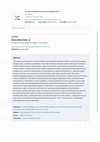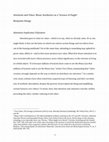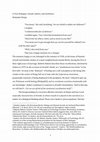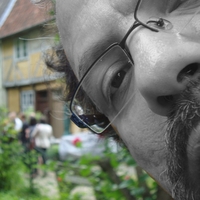Books by Benjamin Steege
Oxford University Press eBooks, Apr 20, 2023

An Unnatural Attitude traces a style of musical thought that coalesced in the intellectual milieu... more An Unnatural Attitude traces a style of musical thought that coalesced in the intellectual milieu of the Weimar Republic—a phenomenological style that sought to renew contact with music as a worldly circumstance. Deeply critical of the influence of naturalism in aesthetics and ethics, proponents of this new style argued for the description of music as something accessible neither through introspection nor through experimental research, but rather in an attitude of outward, open orientation toward the world. With this approach, music acquires meaning in particular when the act of listening is understood to be shared with others.
Benjamin Steege interprets this discourse as the response of a young, post–World War I generation amid a virtually uninterrupted experience of war, actual or imminent—a cohort for whom disenchantment with scientific achievement was to be answered by reasserting the value of imaginative thought. Steege draws on a wide range of published and unpublished texts from music theory, pedagogy, criticism, and philosophy of music, some of which appear for the first time in English translation in the book’s appendixes. An Unnatural Attitude considers the question: What are we thinking about when we think about music in non-naturalistic terms?

The musical writings of scientist Hermann von Helmholtz (1821–94) have long been considered epoch... more The musical writings of scientist Hermann von Helmholtz (1821–94) have long been considered epoch-making in the histories of both science and aesthetics. Widely regarded as having promised an authoritative scientific foundation for harmonic practice, Helmholtz can also be read as posing a series of persistent challenges to our understanding of the musical listener. Helmholtz was at the forefront of sweeping changes in discourse about human perception. His interrogation of the physiology of hearing threw notions of the self-possessed listener into doubt and conjured a sense of vulnerability to mechanistic forces and fragmentary experience. Yet this new image of the listener was simultaneously caught up in wider projects of discipline, education and liberal reform. Reading Helmholtz in conjunction with a range of his intellectual sources and heirs, from Goethe to Max Weber to George Bernard Shaw, Steege explores the significance of Helmholtz's listener as an emblem of a broader cultural modernity.
Papers by Benjamin Steege

The Oxford Handbook of the Phenomenology of Music, 2023
This introduction presents a critical overview of the phenomenology of music, examining its origi... more This introduction presents a critical overview of the phenomenology of music, examining its origins, history, limits, and future possibilities. Since Plato, Western discourse about music has articulated a con ict between music's mathematical, objective properties and its e ects on embodied, situated human subjects. Edmund Husserl, the founder of phenomenology, approached similar philosophical problems via a theory of intentionality. If consciousness is always intentional (i.e., directed toward things), then there is an essential correlation between the subject and the world. Since 1900, phenomenological analysis of musical problems has taken several forms: (1) from around 1910 to 1940, a quest to de ne the very object of musical phenomenology in opposition to the contemporaneous trend toward a "naturalistic" music aesthetics; (2) from around 1940 to 1970, greater concern with aesthetic production (including both performance and modernist poetics); (3) from around 1970 to around 2000, the prioritization of musical "experience" as a counterweight to music-theoretical abstractions; and (4) from 2000 to the present, a growing acknowledgment of embodiment, technology, and the interaction of the two. Because musical form is generated through time, because we make and feel music with our bodies and instruments, because music communicates shared meaning with others, and because music is performed in diverse social contexts, a phenomenology of music must work with key themes of phenomenology itself-time-consciousness, embodiment, intersubjectivity, and the lifeworld.

Testing Hearing: The Making of Modern Aurality, edited by Viktoria Tkaczyk, Mara Mills, and Alexandra Hui, 2020
In response to the devastating human and environmental impact of U.S. nuclear testing in the mid-... more In response to the devastating human and environmental impact of U.S. nuclear testing in the mid-1950s, the philosopher Günther Anders concluded that it was meaningless in such situations to distinguish between “test” and “reality.” In a surprising twist of thought, the radical putting into question of life, brought about by the global nuclear experiment, led Anders to turn to what initially appears an unrelated interest in the phenomenology of musical hearing. Where the fact of worldhood was being put to the test, he responded with a provocative call to “test” in kind the limits to which one might extend the capacity for imagination through desperate acts of aesthetic listening and sober exercise in “techniques of feeling.” Meanwhile, an opportunity for exploring Anders’s ideas appears in a reworking of one of his thematically germane texts in the context of a 1962 electronic composition by his contemporary Herbert Eimert.

Journal of the American Musicological Society, 2019
How we hear music: this became a problem in the nineteenth century. 103 What is required to begin... more How we hear music: this became a problem in the nineteenth century. 103 What is required to begin writing a history of listening? Presumably, you want more than simply a wealth of historical record ready to hand, whether concerning audience behaviors, taste publics, or media technologies, let alone shifts in style or compositional poetics. Rather, before that, you need some motive and aptitude for reflecting, often quite speculatively, on what listening might even be such that it can be understood as susceptible to change at all. This would, one supposes, involve both an openness to the particularity of auditory acts themselves as an aspect of life, and also some practice in techniques of description in order to be able to register something about the character of listening that would escape ordinary recognition. Yet such an aptitude would further, one might equally suppose, spring up at moments in which some dissatisfaction is provoked by something in one's own circumstances, dissatisfaction as much with available modes of audition as with available modes of describing audition. Thinking, it has been said, may well begin with disappointment. 104 My contribution to this colloquy dwells on one such moment, a pair of Weimar-era texts in which the object of disappointment is nothing less than "nineteenth-century musical attention" itself. To the extent that the ranks of the dissatisfied and disappointed-no less than those of the passionately and even radically thoughtful-are often occupied disproportionately by people in their twenties, it is fitting that the chosen case here involves the conjunction of two twentysomethings who at the moment in question were just stepping into public view as professional thinkers: Heinrich Besseler (1900-69) and Günther Stern, later Anders (1902-92). Their published reflections from the years 1925-28 convey a vivid moral urgency about the stakes involved in the interpretation of what it might mean to hear music in a state of 103. Besseler, Das musikalische Hören der Neuzeit, 5: "Wie man Musik hört, das ist im 19. Jahrhundert zum Problem geworden." Translations are mine unless otherwise indicated. 104. Critchley, Infinitely Demanding, 1-3.

Nineteenth-Century Opera and the Scientific Imagination, edited by David Trippett and Benjamin Walton, Nov 25, 2019
For several months beginning in 1884, readers of Life, Science, Health, the Atlantic Monthly and ... more For several months beginning in 1884, readers of Life, Science, Health, the Atlantic Monthly and similar magazines would have encountered half-page advertisements for a newly patented medical device called the "ammoniaphone." Invented and promoted by a Scottish doctor named Carter Moffat and endorsed by the soprano Adelina Patti, British Prime Minister William Gladstone and the Princess of Wales, the ammoniaphone promised a miraculous transformation in the voices of its users. It was recommended for "vocalists, clergymen, public speakers, parliamentary men, readers, reciters, lecturers, leaders of psalmody, schoolmasters, amateurs, church choirs, barristers, and all persons who have to use their voices professionally, or who desire to greatly improve their speaking or singing tones." Some estimates indicated that Moffat sold upwards of 30,000 units, yet the ammoniaphone was a flash in the pan as far as such things go, fading from public view after 1886...

History of Humanities, 2017
's "Studies on the Tone System and Music of the Japanese" (1903) is a classic representative of c... more 's "Studies on the Tone System and Music of the Japanese" (1903) is a classic representative of comparative musicology, bringing together a heterogeneous array of methodologies constituting the early discipline. But what did the two Berlin psychologists aim to accomplish with this document? Understanding the central, unstated project of early comparative musicology requires an evaluation of its fundamentally psychologistic character and of the ethical potential the new psychology was thought to bring. Despite its wealth of ethnological detail, "culture" as such was in fact precisely what these authors sought to bracket out in order to isolate a psychological element that would transcend forms of difference and work against polygenist race thinking. Yet their insistence on the foundational significance of raw psychological apprehension was also a weakness insofar as it left the project open to the very racially inflected modes of thought it otherwise resisted. O tto Abraham and Erich Moritz von Hornbostel, two Berlin psychologists associated with the research program commonly known as comparative musicology (a forerunner of today's ethnomusicology), begin their sixty-page 1903 essay on Japanese music with an abrupt juxtaposition of the discontinuous cultural spaces of the theater and the laboratory. The occasion for their contribution, they tell us, was a run of performances by the musical theater troupe of Kawakami Otojirō-starring the highly regarded actress, dancer, and instrumentalist known as Sadayakko-who had passed through Berlin two years earlier as part of a hugely successful European tour managed by modernist icon Loïe Fuller. 1 Abraham and Hornbostel immediately note that Sadayakko herself had assisted their research by agreeing

Music and Letters, 2017
When the philosopher and critic José Ortega y Gasset (1883-1955) diagnosed the literature and mus... more When the philosopher and critic José Ortega y Gasset (1883-1955) diagnosed the literature and music of the post-First-World-War generation as an art of ‘dehumanization’, he singled out Claude Debussy as a formative exemplar. But what exactly would a ‘dehumanized’ music sound like? More difficult, what attitude are we to adopt towards a poetics that ostensibly defined itself in opposition to lived human experience? Lesser known than Ortega, but equally caught up in the heyday of interwar phenomenology and its antipsychologistic spirit, the philosopher Günther Stern (1902-92) likewise singled out Debussy as the exemplary music for a mode of attention that had been overlooked and misrecognized by traditional aesthetic and psychological discourse. In particular, Ortega’s idea of ‘outward concentration’ merits comparison with Stern’s description of a disposition of ‘letting oneself go’ -- two unfamiliar yet richly imagined attitudes that reflect a concern to think an aesthetics adequate to their contemporary moment.

Keywords in Sound, edited by David Novak and Matt Sakakeeny, 2015
Benjamin Steege acoustics An Irony of Definition Acoustics conventionally designates the branch o... more Benjamin Steege acoustics An Irony of Definition Acoustics conventionally designates the branch of physics concerned with sound. Like physics in general, acoustics is not simply a subject matter or body of knowledge. Just as "physics" is not synonymous with "the physical" (as in "the physical world"), "acoustics" is not synonymous with "the acoustical" (as in "acoustical phenomena"). Physics is probably best described rather as a mode of knowledge, a way of knowing about the world, one that brings into focus quantifiable aspects of matter, force, and motion. So we might say that acoustics, by extension, is a way of knowing about sound, one that brings into focus quantifiable aspects of matter, force, and motion involved with it. But this intuitive distinction opens up onto a more surprising margin between acoustics and its nominal object. In a strange turn of historical events, it has become possible, perhaps even common, to define acoustics in almost completely nonaural terms. As one representative textbook has it, "acoustics as a science may be defined as the generation, transmission, and reception of energy as vibrational waves in matter"-a pithy yet broad formulation that says precisely nothing about sound-as-heard. Acoustics here is simply the physics of vibration, with hearing reduced to the bet-hedging "reception," which could just as easily refer to a microphone or recording device as to an ear. We read further that the form of energy in question involves "tensile force when a spring is stretched, the increase in pressure produced when a fluid is compressed, and the restoring force produced when a point on a stretched wire is displaced to its length." Sensory experience, finally, is adduced only as a special case (albeit a particularly well-known one) of such patterns of movement: "the most familiar acoustic phenomenon is that associated with the sensation of sound" (Kinsler et al. 2000: 1).

Journal of the American Musicological Society, 2011
Leoš Janáček's fascination with the trappings of experimental psychology has boosted his image as... more Leoš Janáček's fascination with the trappings of experimental psychology has boosted his image as a kind of realist, for whom empirical engagement with psychological experience was a prerequisite for aesthetic value. Yet careful contextualization of the sources he drew upon in later years suggests that such discourses—above all, the work of Wilhelm Wundt—work ironically against the constitution of the expressive subjectivity we are used to inferring in his work. An emblematic case in point is Janáček's use of an experimental research instrument known as the "chronoscope," which psychologists had traditionally used for studying reaction times, a formative concern for the discipline since its emergence in the 1870s. While remarkable for its utility in accurately measuring extremely short durations, the chronoscope also highlighted the temporal limits of perception. It appealed to the composer' obsession with minute details of sensation, but it can also be seen to raise questions about the integrity or continuity of the very image of subjectivity it was meant to ascertain. The conjunction of the chronoscope's dramatization of short timespans and Janáček’s related concern for the calibrated gesture together suggest a mode of interpretation through which the expressive impulse in his music may be sensed as incipient, in a state of deferral, rather than as the immediate manifestation of an integral lyrical self.

Journal of Music Theory, 2010
Hermann von Helmholtz’s theory of melodic “affinity,” which he considered his primary contributio... more Hermann von Helmholtz’s theory of melodic “affinity,” which he considered his primary contribution to music-theoretical thought, is inherently historicist in its conception. It seeks not only to explain local tonal relationships but also to provide a rationale for transhistorical change in musical structures. Yet this historical dimension, in many ways typical of its era, is complicated by a tenuous balance between the determinism demanded by rigorous scientific explanation and Helmholtz’s evident desire to preserve a complex role for the “choice” of fundamental aesthetic principles. Such principles would include the very parameters of modern tonality, so the status of tonal “affinity,” a seemingly given and predictable attribute of musical tones, coexists uneasily in Helmholtz’s writing with a humanist appreciation for the unpredictability of cultural choice and change. It also throws the physiological basis of his music theory into conflict with his ostensibly progressive treatment of non-European musics. Such tensions, along with unevenly successful efforts to resolve them, were by no means atypical of the liberal discourse of his intellectual milieu. Indeed, the unresolved challenge of reconciling a flexible aesthetics and historiography with the logical requirements of positivist knowledge aligns Helmholtz with major liberal thinkers from John Stuart Mill on.
Zeitschrift der Gesellschaft für Musiktheorie, 2010
The Oxford Handbook of Neo-Riemannian Music Theories, 2011
Drafts by Benjamin Steege

Attention goes to what we value-which is to say, what we already value. Or so one might think. Is... more Attention goes to what we value-which is to say, what we already value. Or so one might think. Is this not the basis on which one selects certain things and not others from out of the buzzing multitude? Yet at the same time, attending to something may uphold its given value, affirm it-and in that sense produce new value. What first draws attention is in turn invested with more robust presence, more robust significance, in the extreme arriving at a fetish object. "It is because millions of tourists have come to see the Mona Lisa that millions of tourists rush to see the Mona Lisa," writes Yves Citton, maintaining that "valuecreation strongly depends on the way in which we distribute our attention." 1 In a similar vein, music scholars have often noted how acquired ways of listening, and their correlate acts of aesthetic description, deepen the grooves of perception by fixing and amplifying certain features over others. 2 It seems, then, that attention and valuation coincide, neither preceding the other, neither reducing to the other.

I nodded again. "Can I steal this formulation from you?" "Steal from me where, when, and as much ... more I nodded again. "Can I steal this formulation from you?" "Steal from me where, when, and as much as you like!" "You mean you've got enough that you can let yourself be robbed? Live with the door open?" "Well, I also steal from you." That was a happy moment, for a change. 1 The moment, happy or not, belonged to the summer of 1930, at the home of Hannah Arendt and Günther Anders in a quiet neighborhood outside Berlin, during the first of their eight years of marriage. Babette Babich describes these recollections, sketched by Anders in 1975 on the occasion of Arendt's death, as a "posthumous love letter" to his first wife. 2 At issue is the "dishonor" of feeling one's self-conception as the being who resides at the center of things fall out of step with the Copernican awareness, perpetually renewed, of being displaced to the periphery. We have "refused to give up our Ptolemaic world-feeling (Weltgefühl), and to coordinate ourselves emotionally with our knowledge," Anders continues in response to Arendt's formulation. "And to this day, we still don't!... For we are afraid of the emotional coordination itself." 3 The foregrounding of a recursive affective structure of shame and fear is not especially characteristic of Arendt, in whose mouth it is placed in the narration as a matter of a dialogical thinking-aloud. Those were Anders's preoccupations. 4 But the











Uploads
Books by Benjamin Steege
Benjamin Steege interprets this discourse as the response of a young, post–World War I generation amid a virtually uninterrupted experience of war, actual or imminent—a cohort for whom disenchantment with scientific achievement was to be answered by reasserting the value of imaginative thought. Steege draws on a wide range of published and unpublished texts from music theory, pedagogy, criticism, and philosophy of music, some of which appear for the first time in English translation in the book’s appendixes. An Unnatural Attitude considers the question: What are we thinking about when we think about music in non-naturalistic terms?
Papers by Benjamin Steege
Drafts by Benjamin Steege
Benjamin Steege interprets this discourse as the response of a young, post–World War I generation amid a virtually uninterrupted experience of war, actual or imminent—a cohort for whom disenchantment with scientific achievement was to be answered by reasserting the value of imaginative thought. Steege draws on a wide range of published and unpublished texts from music theory, pedagogy, criticism, and philosophy of music, some of which appear for the first time in English translation in the book’s appendixes. An Unnatural Attitude considers the question: What are we thinking about when we think about music in non-naturalistic terms?